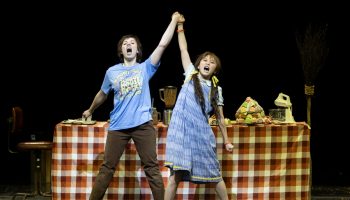At 2:30 p.m. on Sunday, July 29, in the Amphitheater, the Institution will offer a special inter-arts sampler of its artistic riches. The Chautauqua Symphony Orchestra, under Rossen Milanov’s baton, will collaborate with Chautauqua School of Dance, Chautauqua Opera Company, Chautauqua Theater Company and students from the School of Music, celebrating the highlights of the season’s roster.
The Institution’s arts schedule, intertwined with the many fascinating insights during each week’s social themes, can be overwhelming to first-time attendees — and even veterans — hoping to immerse themselves into everything time will allow. A bewildering cornucopia of recitals, master classes, competitions, theater offerings and lectures crowd the schedule — along with the more visible Amphitheater programs. Less apparent are the training sessions held for all disciplines, allowing fortunate students of music, dance, theater and opera to hone their craft under the guidance of major mentor figures.
The ability of the Institution’s diverse talents to perform impressive events with scant rehearsal time is a measure of their remarkable skill and mature professionality. They all perform to great acclaim, continually raising their individual standards, though operating as separate entities.
Five years ago, a visionary idea appeared to Chautauqua planners, including then-Vice President and Director of Programming Marty Merkley. Why not combine the versatility and talent of all our performers in a challenging inter-arts show, one which would demonstrate the Institution as a major American creative force? All the talent and creativity was already here, so having each of these artistic pursuits interact in a unified program was a brilliant and revelatory idea — yet so ideal in its conception that it ultimately became a victim of its own success.
Audiences in July 2013 were stunned by the first of three shows, a highly integrated and brilliantly designed Romeo & Juliet Project. Weeks of rehearsal and planning by an army of creative minds had gone into this show, which combined all four disciplines into a riveting evening. There were three Romeos and three Juliets, speaking immortal Shakespeare verse, dancing to Prokofiev’s stirring ballet score and singing sections from Gounod’s popular opera, with Leonard Bernstein’s West Side Story excerpts an essential inclusion. The unique essences of the production were the seamless and completely organic transformations from one discipline to another, a magical connection with the audience only possible through weeks of creative collaboration.
It was then announced that the next two seasons would feature shows titled Go West! and Carmina Burana, the last based on the popular Carl Orff work.
Many participants and writers, including this one, were asked their thoughts about the endeavor and how it could elevate the reputation of Chautauqua Institution to a wider scale. My thoughts were unhelpful: why not take it on the road (too complex, with the participants soon to be scattered); why not do next year’s show twice (cast-in-stone evening scheduling commitments envisioned at that time); and why not repeat it next year as well as the new work (same practical restrictions as the first two ideas). It seemed unfortunate that the immense amounts of teamwork and talent involved in such a show will only be given once. The Amphitheater may have been absolutely packed with Institution attendees, yet, if the idea was to bring in an outside audience for a unique show, it sadly didn’t appear to have reached that objective.
Go West! was nearly as spectacular as The Romeo & Juliet Project, again well-conceived and imaginative, with commentary on immigration, American Indian treatment, climate change and Western history in its structure. The dance company emulated the movements assumed by the pioneers’ Shoshonean interpreter Sacagawea with flute solo, as well as to orchestral music from Aaron Copland’s barn-dance period. Gold Rush days were emulated in a lovely “Paint Your Wagon” melody and, after intermission, Joplin rags accompanied video of Buster Keaton, Mae West and the Marx Brothers in apt excerpts. The Okies, Andrew Jackson’s brutal policies, Pocahontas, John Williams, Walt Whitman and many more subjects swirled by in the savvy hands of each discipline. The challenge was to pack a world into one evening, but it could hardly have been conceived more compellingly.
Illness prevented a visit to experience Carmina Burana, which was given two performances with reportedly the same grand-scale inter-arts vision.
The practicality and time drain involved in these three shows necessitated reflection on their value, without such a show in 2016. But last year, a more modestly-conceived piece, Mango Suite, brought together several disciplines without such exhaustive gestations as the three larger shows. A staple of children’s literature for over three decades, the story of Esperanza, a young girl about to transform into a challenging womanhood while dreaming of a better life than in her gritty neighborhood, turned out to be a memorable choice of subject in this half-evening gem. Composer Derek Bermel’s close association with Milanov at Princeton was an advantage, and his vocal writing and scoring for some magnificent dance sections brought us into Esperanza’s world.
These were all expertly conceived shows which never traveled past the Amphitheater, a bonanza for Institution audiences but a secret from the outside world. There might be no future answer for celebrating more widely the enormous wealth of talent crammed into this island of the arts. But, for now, don’t miss Sunday’s rich inter-arts demonstration of what is, and what could be.
Tom Di Nardo has written on the arts for the Philadelphia Daily News since 1982. His recent books include Listening To Musicians: 40 Years of the Philadelphia Orchestra and Performers Tell Their Stories: 40 Years Inside the Arts. He has also written Wonderful World of Percussion: My Life Behind Bars, a biograp





